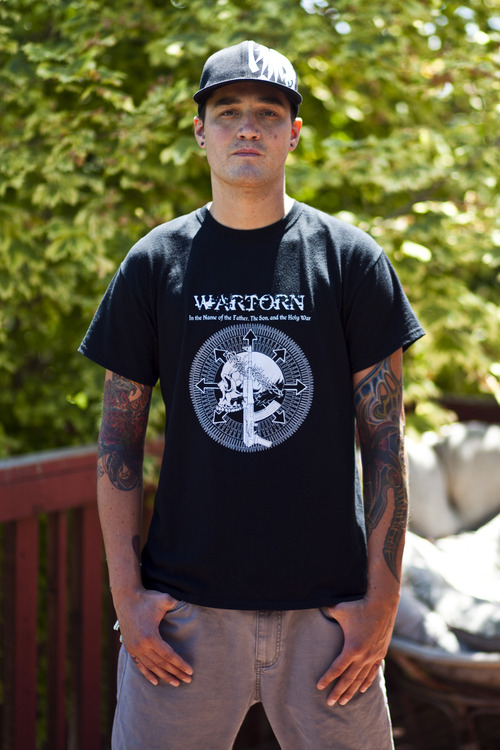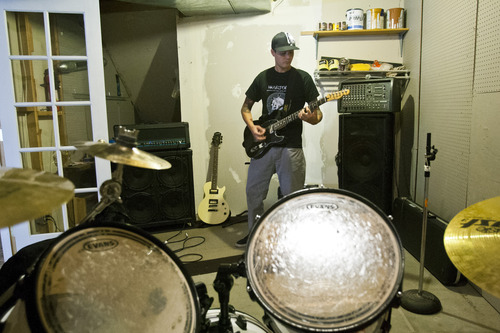This is an archived article that was published on sltrib.com in 2013, and information in the article may be outdated. It is provided only for personal research purposes and may not be reprinted.
Josh Leland knows a few things about heroin addiction.
He knows that a lighter, a hollowed out pen and a square of tinfoil can be the difference between euphoria and depression. He knows the best way to consistently have cash on hand is by working restaurant jobs — tip money is essential when that early-morning dope sick creeps through your system. He knows pawn shops don't ask questions, dealers don't mind dropping by on Christmas and setting your alarm clock to sound every 15 minutes is a decent way to ensure you won't die in your sleep like three of his friends did.
When you smoke heroin every two hours for the better part of seven years, you learn some tricks.
Leland, who's been clean for 17 months, also knows he reacts much differently to certain news these days, like when authorities announced the largest heroin bust in Utah history on July 18, taking 90 pounds total from Arizona and Utah and 30 pounds off the local market.
"When I first heard about it I felt this sense of relief, like 'Oh thank God they got all this off the street,'" Leland said. "And then I started thinking about what I would have felt back in the day, and I would have went into instant panic mode if I would have heard that. Getting news like that would have been the equivalent of getting news that, like, a family member died."
Leland and local authorities agree that the heroin trade is prolific in Utah. Most of it comes up through the southwest border, sent by Mexican cartels. The cartels are business-minded, and they understand the basic concept of supply and demand. And in Utah, the demand for heroin is pronounced.
"[The July bust] is a drop in the bucket," said Salt Lake County Sheriff Jim Winder. "I mean, the volume of importation I think is clearly highlighted by this bust. The heroin that we took out both here and in Arizona represents really what I would consider to be a single delivery of anywhere from possibly dozens or more a month."
—
Deadly consequences • Like many users, Leland, 33, turned to heroin because maintaining his love affair with prescription pain meds required too much effort. Doctors set appointments, run tests, ask questions. Heroin dealers only ask two questions: Where and how much?
At the height of his addiction, Leland was smoking a gram of heroin per day. Local narcotics officers say that is probably a little more than the average addict, but they have encountered users who were consuming as much as two or three grams a day.
Often times, those users end up in rehab. According to the Utah Division of Substance Abuse and Mental Health, 17,264 people were admitted to publicly funded drug treatment centers in 2012. Of those, 21.2 percent said heroin or other opiates were their primary substance. Only alcohol was a more common source of admissions. Among young adults, heroin is particularly rampant, with nearly a third of patients ages 18 to 35 saying it was their drug of choice.
Many times, those who don't go to rehab go to the mortuary. According to the Center for Disease Control and Prevention, 508 people in Utah died from drug-induced deaths in 2009. That's slightly fewer than the combined number of people who died from firearms and car accidents that same year. On the national scale, Utah's drug-induced death rate of 18.2 deaths per 100,000 people in 2009 greatly exceeded the country's average of 12.8.
The deadly nature of drug addiction is the main reason authorities rejoiced when they landed July's 90-pound bust after a six-month, multi-agency effort. Although Salt Lake County District Attorney Sim Gill agreed with Winder that the amount seized was "probably a blip in the flow of heroin" that comes through the state, he said it's important to maintain perspective.
"When you take something that may be as small as a fraction of my thumbnail and put that in the context of one pound and then in the context of multiple pounds or 30 pounds or 90 pounds, you can see that we're talking about an incredible amount of dosages that are going to be consumed out at the street level," Gill said.
To fully grasp the magnitude of July's bust, he said, one must understand that heroin is most commonly sold in balloons that typically hold about a tenth of a gram. That means that one pound of heroin could supply 50 addicts with 10 balloons — or one gram, the amount Leland was consuming — per day for just more than nine days. Thirty pounds would supply 1,000 addicts with that same amount for just more than 13 days. And the total bust would supply 2,000 addicts with one gram per day for just more than 20 days.
"So when you start to break it down by those little micrograms of distribution and consumption, the reach of it, even several pounds of it, becomes tremendous," Gill said. "And then all the pain and suffering and heartache and the criminality that's attached to that, that only magnifies proportionally."
—
Intervention • Leland, who said that he tried to quit smoking heroin about 20 times before finally succeeding, knows that pain and suffering and heartache as well as anyone.
"It turned me into a monster," Leland said. "I was just this tornado of negativity, just swirling around and everyone was getting caught up in my stuff. It wasn't just me that I was destroying, it was everyone around me."
Leland's addiction eventually became so bad that he couldn't hold a job. With past-due bills piling up and a habit to support, he resorted to stealing from whoever he could. He would steal bikes from garages, laptops from girlfriends, cash from his family. He said he took hundreds, possibly even thousands, of dollars from his father. But it was never enough. At his most desperate time, he crafted a plan to rob a bank.
Leland said he thought about it for a month. He staked out the bank for several hours at a time, trying to decide when business was at its slowest. He found a Dumpster around the corner where he could stash a change of clothes and mentally mapped out the quickest route to the train station on foot. He even picked out a date when he would slide a note to the teller, silently announcing that he had a gun and wanted all the money in the register. But on the morning of the heist, his older brother — who didn't know about his plan — kidnapped Leland and brought him back to his house, forcing him to stay there for a week and detox.
Leland was furious at his brother, but looking back at it about a year and a half later, he's grateful for the event that he called "some real higher-power s—-."
"Man, I was gonna rob a bank," Leland said. "I'd probably be in prison right now. That's where my life was headed — either death or prison, and I was heading both of those places extremely fast."
Fortunately for Leland, his life has improved dramatically. He's completely sober, he's going to college in the fall, and he's working at the same sushi restaurant that once fired him when he was strung out. He often becomes angry at himself for his past mistakes, but he recently got a tattoo on the inside of his right wrist that reminds him to not be so hard on himself, to appreciate that he's one of the lucky ones who has survived heroin addiction. "Mercy Me," it reads.
Twitter: @AustinAGreen











